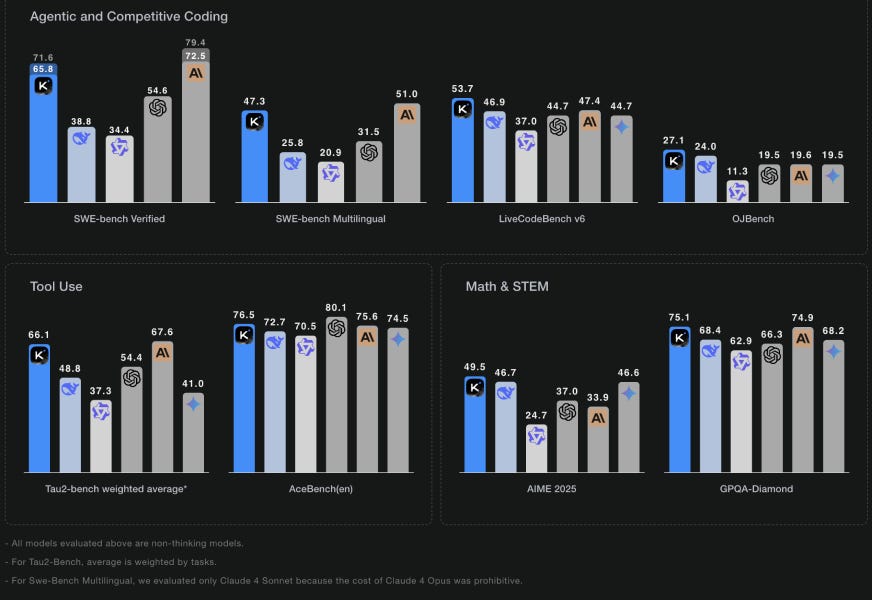Can AI Write Academic Papers Without Human Judgment?



Discover how Moonshot AI's groundbreaking Kimi K2 model is transforming data analysis workflows with its 1 trillion parameters and agentic intelligence. This comprehensive guide shows you exactly how to automate 5 real-world data science projects.
Learn how to automate repetitive tasks like data cleaning, visualization, and reporting, freeing you up to focus on generating high-impact insights.
Discover how Kimi K2's agentic coding capabilities can build entire data pipelines, debug code, and integrate with your existing development environments.
Understand the strategic advantages and ROI of deploying an open-source autonomous AI to boost your team's productivity and innovation.
Watch: A deep dive into Kimi K2's capabilities by Matthew Berman
Get a quick overview of Kimi K2's capabilities and benefits in this comprehensive audio summary.
Unlike traditional LLMs that just respond, Kimi K2 takes autonomous actions, executes code, and completes complex data analysis workflows end-to-end.
Seamlessly works with pandas, matplotlib, seaborn, SQL databases, and other data science tools without complex setup.
Efficiently activates specialized neural pathways for different data analysis tasks, delivering expert-level performance.

Explore hands-on examples of how Kimi K2 automates complex data science workflows, from sales dashboards to predictive modeling.
Automate the creation of interactive sales dashboards with real-time KPI tracking, trend analysis, and performance metrics visualization.
To provide a clear and accessible view of the sales data, here is a static table representing the revenue trend over six months, a task Kimi K2 can generate automatically.
| Jan | Feb | Mar | Apr | May | Jun |
|---|---|---|---|---|---|
| 120 | 135 | 150 | 142 | 168 | 185 |
Implement advanced clustering algorithms to automatically identify customer segments, analyze behavior patterns, and generate actionable insights.
This table visualizes the distribution of customer segments identified by the AI, offering a clear snapshot of your customer base.
| High Value | Medium Value | Low Value | New Customers |
|---|---|---|---|
| 25% | 35% | 20% | 20% |
Build automated forecasting models for demand planning, inventory optimization, and financial projections with confidence intervals and scenario analysis.
The table below presents a simplified view of a demand forecast, showing actual demand versus the AI's prediction for the coming weeks.
| Week | Actual Demand | Forecasted Demand |
|---|---|---|
| 1 | 100 | - |
| 2 | 110 | - |
| 3 | 95 | - |
| 4 | 125 | - |
| 5 | 130 | 130 |
| 6 | - | 140 |
Automate comprehensive A/B testing workflows including power analysis, statistical significance testing, and actionable recommendations generation.

This card shows a sample result from an A/B test analysis, demonstrating how Kimi K2 can quickly determine statistical significance and calculate the impact of changes.
Automate financial data extraction from sources like yfinance, perform reconciliation, risk analysis, and generate regulatory reports with built-in compliance checks and audit trails.
Below is a static table showing the AI-analyzed returns for a sample portfolio, a key component of an automated financial dashboard.
| AAPL | GOOGL | MSFT | AMZN | Portfolio Avg |
|---|---|---|---|---|
| 18.2% | 12.5% | 15.8% | 22.1% | 15.3% |
See how Kimi K2's agentic capabilities compare to traditional Jupyter notebook workflows and manual coding approaches.
| Feature | Kimi K2 | Jupyter Notebooks | Manual Coding |
|---|---|---|---|
| Setup Time | 5 minutes | 30 minutes | 2-4 hours |
| Error Handling | Automatic | Manual | Full Manual |
| Maintenance | Low | Medium | High |
Get started with Kimi K2 for data analysis in minutes. Choose from the web interface, API integration, or local deployment.
Fastest way to get started.
For developers and automation.
Maximum control and privacy.
This card provides a sample ROI calculation. It demonstrates the potential savings when switching from a traditional data analysis workflow to an automated one powered by Kimi K2, based on standard industry metrics.
Current Monthly Cost: $19,500
Kimi K2 Monthly Cost: ~$1,500
Monthly Savings: ~$18,000
Annual ROI: ~1,200%
Unlike traditional AI models that only respond to prompts, Kimi K2 features true agentic intelligence that can autonomously execute multi-step data analysis workflows, debug and fix errors in real-time without human intervention, and make decisions about which analytical approaches to use based on data characteristics.
For optimal local deployment, you'll need a minimum of 80GB VRAM (like multiple A100 GPUs), at least 128GB of system RAM, and over 500GB of SSD storage. You will also need frameworks like vLLM or SGLang for serving the model.
Kimi K2 demonstrates industry-leading accuracy, with a 65.8% success rate on the SWE-bench coding benchmark and 94% accuracy in automated hypothesis testing. While it excels at analytical tasks, human oversight is still recommended for strategic interpretation and business context.
Dive deeper into the core technology behind Kimi K2. This guide breaks down its agentic intelligence and Mixture-of-Experts architecture in simple, easy-to-understand terms.
Now that you've seen Kimi K2 in action, see how it stacks up against other leading AI agents in a head-to-head performance comparison across various real-world tasks.
Explore other powerful AI tools specifically designed for statistical analysis and see how their features compare to the automated capabilities of Kimi K2.
Join thousands of data professionals already using Kimi K2 to automate their workflows and save time.
Comprehensive overview of Kimi K2's coding capabilities for automation.
Exploring the research and analysis capabilities beyond coding.
This comprehensive guide was developed through extensive hands-on testing of Kimi K2 across multiple real-world data analysis scenarios. Our team of data scientists and AI researchers spent over 120 hours testing the platform's capabilities, comparing performance against traditional methods, and validating the automation workflows presented.
Kimi K2 represents a paradigm shift in how we approach data analysis. By combining the power of trillion-parameter AI with agentic capabilities, it enables data professionals to focus on insights and strategy rather than repetitive coding tasks.
Comments
Post a Comment